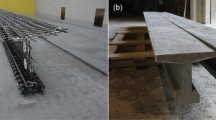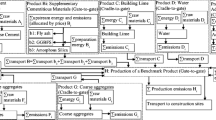Abstract
One solution for reducing the environmental impact of the civil construction industry is to incorporate by-products and waste from other industries into materials such as concrete, which is the most commonly used construction material. Therefore, this study presents a comparison of the production of self-compacting concrete containing mineral admixtures in a Brazilian context. To compare mixtures fairly, it is necessary to use indicators that incorporate all the relevant aspects; therefore, two environmental impact indicators were used, considering mechanical strength and service life (SL) as parameters. The concrete mixtures studied contained ground granulated blast-furnace slag (GGBFS) and fly ash at replacement levels of 20, 30, and 40%. Life-cycle assessment (LCA) is a method that can be used to quantify the environmental impact of a product throughout its life cycle. SimaPro software was used as a tool to perform the LCA. To assess the durability of concrete, the SL of each mixture was estimated using Life-365 software. The difference in the clinker transportation of different cement suppliers was an important parameter in the analysis. Based on all of the indicators analyzed, it was concluded that utilization of the highest GGBFS content in the cement was the environmentally preferable solution.





Similar content being viewed by others
Notes
1 ton of oil equivalent (toe) = 41.87 GJ.
References
ABNT (Associação Brasileira de Normas Técnicas). (1991). NBR 5732-Cimento Portland comum. Rio de Janeiro: ABNT.
ABNT (Associação Brasileira de Normas Técnicas). (2014). NBR 6118: Projeto de estruturas de concreto – Procedimento. Rio de Janeiro: ABNT.
Alexander, M., Bertron, A., & de Belie, N. (2012). In Performance of cement-based materials in aggressive aqueous environments: State-of-the-Art. RILEM TC 211-PAE.
Andrade, C., Prieto, M., Tanner, P., Tavares, F., & d’Andrea, R. (2013). Testing and modelling chloride penetration into concrete. Construction and Building Materials, 39, 9–18.
ASTM C150. (2012). Standard C150/C150M-12. Standard specification for Portland cement 04.01. West Conshohocken, PA: ASTM International.
Blankendaal, T., Schuur, P., & Voordijk, H. (2014). Reducing the environmental impact of concrete and asphalt: A scenario approach. Journal of Cleaner Production, 66, 27–36.
Carvalho, J. (2002). Análise de Ciclo de Vida ambiental aplicada a construção civil - Estudo de caso: Comparação entre cimentos Portland com adição de resíduos. Dissertation, Escola Politécnica (USP), São Paulo, Bazil.
Carvalho, J. O. (2009). A Indústria do cimento e a Infraestrutura no Brasil. Comissão de serviços de infraestrutura. Senado Federal. Sindicato Nacional da Indústria do Cimento. SNIC.
Castro, A. L., Silva, F. B., Arduin, R. H., Oliveira, L. A., & Becere, O. H. (2015). Análise da viabilidade técnica da adaptação de dados internacionais de inventário de ciclo de vida para o contexto brasileiro: um estudo de caso do concreto para paredes moldadas no local. In Anais do 57º Congresso Brasileiro do Concreto—CBC2015. Bonito, MS. 16p.
Celik, K., Meral, C., Gursel, A. P., Mehta, P. K., Horvath, A., & Monteiro, P. J. M. (2015). Mechanical properties, durability, and life-cycle assessment of self-consolidating concrete mixtures made with blended Portland cements containing fly ash and limestone powder. Cement and Concrete Composites, 56, 59–72.
Chen, C., Habert, G., Bouzidi, Y., Jullien, A., & Ventura, A. (2010). LCA allocation procedure used as an incitative method for waste recycling: An application to mineral additions in concrete. Resources, Conservation and Recycling, 54(12), 1231–1240.
Chiaia, B., Fantilli, A. P., Guerini, A., Volpatti, G., & Zampini, D. (2014). Eco-mechanical index for structural concrete. Construction and Building Materials, 67(Part C), 386–392.
CONAMA. (2011). Resolução Nº 436, de 22 de dezembro de 2011. Published in the DOU Nº 247, 26 December 2011.
Damineli, B. L., Kemeid, F. M., Aguiar, P. S., & John, V. M. (2010). Measuring the eco-efficiency of cement use. Cement and Concrete Composites, 32(8), 555–562.
de Medeiros-Junior, R. A., de Lima, M. G., & de Medeiros, M. H. F. (2015). Service life of concrete structures considering the effects of temperature and relative humidity on chloride transport. Environment, Development and Sustainability, 17(5), 1103–1119.
Dodoo, A., Gustavsson, L., & Sathre, R. (2009). Carbon implications of end-of-life management of building materials. Resources, Conservation and Recycling, 53, 276–286.
Dong, Y. H., Ng, S. T., Kwan, A. H. K., & Wu, S. K. (2015). Substituting local data for overseas life cycle inventories—A case study of concrete products in Hong Kong. Journal of Cleaner Production, 87, 414–422.
Edelen, A., & Ingwersen, W. (2016). Guidance on data quality assessment for life cycle inventory data. V.1. US Environmental Protection Agency (EPA). EPA/600/R-16/096. June 2016.
EFCA (European Federation of Concrete Admixture Associations). (2002). Environmental declaration superplasticizing admixtures. http://www.admixtures.org.uk/downloads/xIS%20Environmental%20Declaration%20Superplasticizer.PDF. Accessed May 13, 2015.
Ehlen, M. A. (2014). Life-365™ service life prediction model™, v, p 2.2.1, users manual.
EPE (Empresa de Pesquisa Energética). (2016). Balanço Energético Nacional 2016: Ano base 2015. Rio de Janeiro: EPE.
Galan, I., Andrade, C., Mora, P., & Sanjuan, M. A. (2010). Sequestration of CO2 by concrete carbonation. Environmental Science and Technology, 44(8), 3181–3186.
García-Segura, T., Yepes, V., & Alcalá, J. (2014). Life cycle greenhouse gas emissions of blended cement concrete including carbonation and durability. The International Journal of Life Cycle Assessment, 19, 3–12.
Goedkoop, M., Heijungs, R., Huijbregts, M., De Schryver, A., Struijs, J. & Van Zelm, R. (2013). ReCiPe 2008: A life cycle impact assessment method which comprises harmonised category indicators at the midpoint and the endpoint level. Report I: Characterisation. 1st edition (version 1.08). Updated May 2013.
Gursel, A. P., Maryman, H., & Ostertag, C. (2016). A life-cycle approach to environmental, mechanical, and durability properties of “green” concrete mixes with rice husk ash. Journal of Cleaner Production, 112(Part 1), 823–836.
Gursel, A. P., Masanet, E., Horvath, A., & Stadel, A. (2014). Life-cycle inventory analysis of concrete production: A critical review. Cement and Concrete Composites, 51, 38–48.
Habert, G. (2013). A method for allocation according to the economic behaviour in the EU-ETS for by-products used in cement industry. The International Journal of Life Cycle Assessment, 18(1), 113–126.
Ingrao, C., Giudice, A. L., Tricase, C., Mbohwa, C., & Rana, R. (2014). The use of basalt aggregates in the production of concrete for the prefabrication industry: Environmental impact assessment, interpretation and improvement. Journal of Cleaner Production, 75, 195–204.
ISO (International Organization for Standardization). (2006a). Environmental management—life cycle assessment—principles and framework. ISO 14040.
ISO (International Organization for Standardization). (2006b). Environmental management—life cycle assessment—requirements and guidelines. ISO 14044.
ISO (International Organization for Standardization). (2012). Environmental management for concrete and concrete structures: Part 1: General principles. ISO 13315-1.
ISO (International Organization for Standardization). (2014). Environmental management for concrete and concrete structures: Part 2: System boundary and inventory data. ISO 13315-2.
John, V. M. (2007). Materiais de construção e o Meio Ambiente. In G. C. Isaia (Ed.), Materiais de construção civil e princípios de ciência e engenharia de materiais (Chapter 4). São Paulo: IBRACON.
Kellenberger, D., Althaus, H.-J., Jungbluth N., Künniger T., Lehmann M., & Thalmann P. (2007). Life cycle inventories of building products. Final report ecoinvent data v2.0 No.7 EMPA Dübendorf, Swiss Centre for Life Cycle Inventories, Dübendorf, CH. www.ecoinvent.org.
Life-365. (2016). Versão 2.2.1, Service life prediction model. http://www.life-365.org. Accessed November 10, 2015.
Marceau, M., & Vangeem, M. G. (2003). Sustainability and slag cement. Slag cement association. http://www.slagcement.org/sustainability/sustainability.html. Accessed May 19, 2015.
Marinković, S., Radonjanin, V., Malešev, M., & Ignjatović, I. (2010). Comparative environmental assessment of natural and recycled aggregate concrete. Waste Management, 30(11), 2255–2264.
MCTIC (Ministério da Ciência, Tecnologia, Inovações e Comunicações). (2016). Estimativas anuais de emissões de gases de efeito estufa no Brasil (3rd ed.). Brasília: MCTIC.
Mehta, P. K., & Monteiro, P. J. M. (2013). Concrete microstructure, properties, and materials (4th ed.). New York: McGraw Hill.
Meijers, S. J. H. (2003). Computational modelling of chloride ingress in concrete. PhD Thesis, Delft University, Delft, Netherlands.
Miller, S. A., Horvath, A., & Monteiro, P. J. M. (2016). Readily implementable techniques can cut annual CO2 emissions from the production of concrete by over 20%. Environmental Research Letters, 11(7), 074029.
MME (Ministério de Minas e Energia). (2009). Relatório Técnico 34 - Perfil da Gipsita. Secretaria de Geologia, mineração e transformação mineral –SGM.
O’Brien, K. R., Menache, J., & O’Moore, L. M. (2009). Impact of fly ash content and fly ash transportation distance on embodied greenhouse gas emissions and water consumption in concrete. International Journal of Life Cycle Assessment, 14(7), 621–629.
Ožbolt, J., Oršanić, F., & Balabanić, G. (2016). Modelling processes related to corrosion of reinforcement in concrete: Coupled 3D finite element model. Structure and Infrastructure Engineering, 13(1), 135–146.
Park, J.-I., Lee, K.-M., Kwon, S.-O., Bae, S.-H., Jung, S.-H., & Yoo, S.-W. (2016). Diffusion decay coefficient for chloride ions of concrete containing mineral admixtures. Advances in Materials Science and Engineering, 2016, 2042918. doi:10.1155/2016/2042918.
Proske, T., Hainer, S., Rezvani, M., & Graubner, C.-A. (2013). Eco-friendly concretes with reduced water and cement contents—Mix design principles and laboratory tests. Cement and Concrete Research, 51, 38–46.
Rebitzer, G., Ekvall, T., Frischknecht, R., Hunkeler, D., Norris, G., Rydberg, T., et al. (2004). Life cycle assessment: Part 1: Framework, goal and scope definition, inventory analysis, and applications. Environment International, 30(5), 701–720.
Seto, K. E., Panesar, D. K., & Churchill, C. J. (2016). Criteria for the evaluation of life cycle assessment software packages and life cycle inventory data with application to concrete. The International Journal of Life Cycle Assessment. doi:10.1007/s11367-016-1060-6.
Silva, M. G., Saade, M., & Gomes, V. (2013). Influence of service life, strength and cement type on life cycle environmental performance of concrete. The IBRACON Structures and Materials, 6, 844–853.
SimaPro. (2016). Faculty Version 8.2.0.0. PRé Consultants.
Struble, L., & Godfrey, J. H. (2004). How sustainable is concrete? In Proceedings of the international workshop on sustainable development and concrete, Beijing. Center for Transportation Research and Education.
Tait, M. W., & Cheung, W. M. (2016). A comparative cradle-to-gate life cycle assessment of three concrete mix designs. International Journal of Life Cycle Assessment, 21(6), 847–860.
Tang, S. W., Yao, Y., Andrade, C., & Li, Z. J. (2015). Recent durability studies on concrete structure. Cement and Concrete Research, 78, 143–154.
Tavares, F. B. (2013). Coupled model of initiation and propagation of corrosion in reinforced concrete. Doctoral Thesis, E.T.S.I. Caminos, Canales y Puertos (UPM), Madrid, Spain.
Valipour, M., Yekkalar, M., Shekarchi, M., & Panahi, S. (2014). Environmental assessment of green concrete containing natural zeolite on the global warming index in marine environments. Journal of Cleaner Production, 65, 418–423.
Van den Heede, P., & de Belie, N. (2012). Environmental impact and life cycle assessment (LCA) of traditional and ‘green’ concretes: Literature review and theoretical calculations. Cement and Concrete Composites, 34(4), 431–442.
Vieira, D. R., Calmon, J. L., & Coelho, F. Z. F. (2016). Life cycle assessment (LCA) applied to the manufacturing of common and ecological concrete: A review. Construction and Building Materials, 124, 656–666.
Zhao, H., Sun, W., Wu, X., & Gao, B. (2015). The properties of the self-compacting concrete with fly ash and ground granulated blast furnace slag mineral admixtures. Journal of Cleaner Production, 95, 66–74.
Acknowledgements
The authors gratefully acknowledge the support of FAPES (Fundação de Amparo à Pesquisa e Inovação do ES–Brazil).
Author information
Authors and Affiliations
Corresponding author
Ethics declarations
Conflict of interest
The authors have no conflicts of interest to declare.
Rights and permissions
About this article
Cite this article
Vieira, D.R., Calmon, J.L., Zulcão, R. et al. Consideration of strength and service life in cradle-to-gate life cycle assessment of self-compacting concrete in a maritime area: a study in the Brazilian context. Environ Dev Sustain 20, 1849–1871 (2018). https://doi.org/10.1007/s10668-017-9970-4
Received:
Accepted:
Published:
Issue Date:
DOI: https://doi.org/10.1007/s10668-017-9970-4




